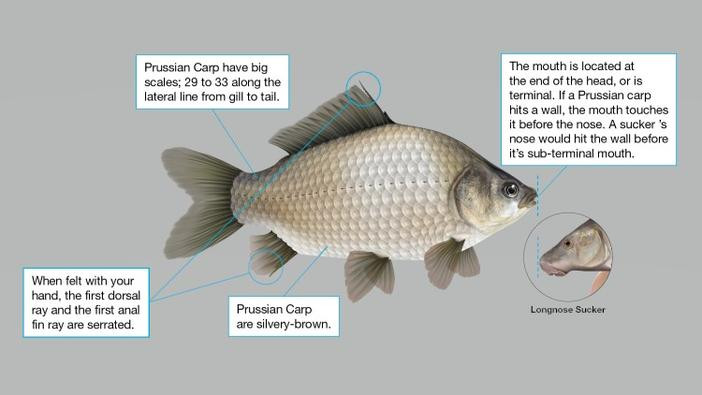Place of origin and introduction to Alberta
Prussian carp (Carassius gibelio) is an introduced fish known to disrupt aquatic ecosystems and pose potential threats to native fish.
Prussian carp is native to central Europe and Asia. It is unknown how this fish species was introduced to Alberta but it is suspected it was through a “goldfish” release. Alberta was the first jurisdiction in North America found to have Prussian carp, which has since spread to Saskatchewan through shared waterways.
Within Alberta, distribution of Prussian carp continues to spread due to natural dispersal and illegal introductions. Prussian carp have been confirmed within the following river watersheds:
- Bow
- North Saskatchewan
- Oldman
- Red Deer
- Rosebud
- South Saskatchewan
Some isolated stocked ponds are reported to have Prussian carp, which indicates the illegal movement of these invasive fish.
Identification
Use keyboard or mouse to scroll through the gallery
- Plump and deep-bodied
- Terminal mouth
- Silver-gold in colour with dark shading at top
- Large scales, 29 to 33 along lateral line
- First dorsal fin ray and first anal fin ray are strongly serrated
Prussian carp can be confused with other fish species present in Alberta.
Similar species: Goldfish
Goldfish (Carassius auratus) are a common invasive species in Alberta with over 100 locations in the wild due to aquarium releases.
Typically, goldfish can be distinguished from Prussian carp by their bright orange colouration. However, goldfish lose their orange colour in the wild, resulting in the goldfish looking identical to Prussian carp. DNA analysis is required to confirm the identification between Prussian carp and goldfish.
Use keyboard or mouse to scroll through the gallery
Similar species: Suckers
Native sucker species, such as the longnose sucker (Catostomus catostomus) and white sucker (Catostomus commersonii), can be mistaken for Prussian carp.
White and long-nose suckers are native fish species to Alberta. Suckers can be differentiated from Prussian carp by their mouth position. They are bottom feeders, and their mouths face downwards, called a sub-terminal mouth.
The mouth of a Prussian carp is located at the end of the head, called a terminal mouth. If a Prussian carp hits a wall, the mouth would touch it before the nose. A sucker’s nose would hit the wall before its sub-terminal mouth.
Use keyboard or mouse to scroll through the gallery
Reproduction
- Females are ready to spawn within one year, and can spawn up to 3 times per year.
- Females can reproduce asexually through gynogenesis, which is a reproductive process that exploits the milt (sperm) of other fish species to activate egg development. Gynogenesis results in all-female populations that are essentially clones, which can further impact native fish populations.
Issues
- Extremely hardy and rapidly reproducing, Prussian carp tolerate low oxygen levels and poor water quality where native fish cannot survive.
- Prussian carp can carry pathogens capable of infecting other fish species.
- The destructive feeding habits of this invasive fish species increases water turbidity, reducing suitable habitat and available food for native fish populations.
- Once Prussian carp are established, they spread easily. It is extremely costly and difficult to manage, contain and remove them.
Current management
- Prevention is the best defence against Prussian carp as there are no selective control measures. Available response options are expensive and time consuming. Prevention is prioritized through education on responsible angling within Alberta waterbodies.
- When feasible, manual removal through netting and angling may be used, but this method is labour intensive.
- Pesticide treatment may be applied against Prussian carp as a last resort. This strategy is often only feasible for use in isolated waterbodies where no other fish species are present.
Take action
If you catch Prussian carp, please kill it and either consume or properly dispose of it in the garbage.
Never release Prussian carp into waterbodies where it was not caught. Possession of live Prussian carp beyond 5 m from the water’s edge is illegal.
Penalties for transferring fish into any water body other than where it was caught can be up to $100,000 and/or a year in prison. See:
Report sightings of aquatic invasive fish:
| By telephone: | Aquatic Invasive Species Hotline 1-855-336-BOAT (2628) |
| Online via mobile or desktop: | EDDMapS Alberta App |
Report any unlawful activities to:
- Report-a-Poacher phone line
1-800-642-3800 (Toll free 24 hours a day, 7 days a week)
Angling for Prussian carp
- A sportfishing licence is required to angle for Prussian carp in Alberta.
- No daily catch, possession or size limits apply to Prussian carp. Follow all other sportfishing regulations (such as waterbody closures and bait bans).
- Confirm the identification of your catch before killing it. If you don’t know, let it go.
- Remember: Catch It, Kill It. Dispose of dead Prussian carp properly. Possession and transportation of live Prussian carp is illegal.
- Never use Prussian carp as bait, dead or alive.





